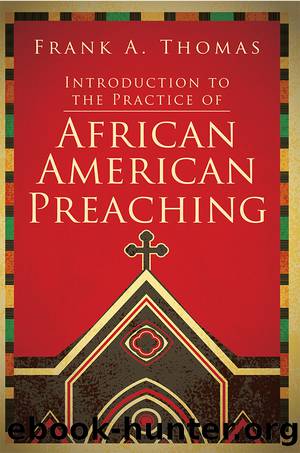Introduction to the Practice of African American Preaching by Thomas Frank A.;

Author:Thomas, Frank A.;
Language: eng
Format: epub
Publisher: Abingdon Press
Published: 2016-10-06T00:00:00+00:00
Black Preaching and Rhetorical Criticism
As discussed on the Bus Tour, Donna E. Allen defines rhetorical criticism as the study of the various persuasive options available to preachers in the creation of their messages and how those options work together to create effects in the preacher and audience.7 Rhetorical criticism allows the critic to see with greater clarity the persuasive choices made by the preacher, and potentially other choices that were not selected. For example, what audience was not mentioned, or, who, in effect, was written out of, or even excluded from the sermon? For Allen, rhetorical criticism is critical in the construction of a womanist homiletic because it can identify âderogatory images of women and patriarchal teachings.â Each preacher is making decisive rhetorical choices that include or exclude audiences, and affect the audienceâs apprehension of the message. Allen believes that knowledge of rhetorical operations on the part of the preacher allows the congregation to respond to and engage the message at the level of âemancipatory praxis.â8 I want to further expand Allenâs appropriation of rhetorical criticism for emancipatory praxis by applying the rhetorical method of close reading to âHis Own Clothes.â First, let me explain what is meant by the use of the term close reading.
An important shift occurred in the field of communication and rhetoric in the last thirty years. Though rhetoric was concerned with human speech, until recently, little attention was paid to the study of the inner workings of specific speeches. Critics interested in studying the inner workings of texts sought insights from the field of literary criticism. With the new attention to the inner depths of speeches, a method of âclose readingâ emerged in rhetorical criticism. According to Michael Leff, one of the leading proponents of close reading, individual and written speech texts have ârhetorical textures,â and a certain âintegrity and density.â Speech texts are not just a compilation of words, sentences, and paragraphs, but rather an organized system of ideas, images, and arguments. The written text is a world in and of itself and within the boundaries of the text are infinite insights into the mind, heart, and belief system of the speaker and the intended audience. Close reading allows the critic to peer deeply into the inner world of the speaker, including the speakerâs persuasive choices and the speakerâs conception of audience.
The critique of close reading was that with such close and microscopic analysis of the inner workings of the text, the critic could lose sensitivity to the social and historical dimensions. If there are an infinite number of insights in the text itself, and the text is a world in and of itself, what is the relationship between text and context? How does context influence the inner workings of the text? The concept of âintertextualityâ emerged as the view that texts cannot be conceived or understood in isolation in and of themselves, but only in relation to other texts and utterances. By adding intertextuality to close reading, one captures the context, the historical and social dimensions of the text.
Download
This site does not store any files on its server. We only index and link to content provided by other sites. Please contact the content providers to delete copyright contents if any and email us, we'll remove relevant links or contents immediately.
| Adult Ministry | Children's Ministry |
| Counseling & Recovery | Discipleship |
| Evangelism | Missions & Missionary Work |
| Preaching | Sermons |
| Youth Ministry |
Victory over the Darkness by Neil T. Anderson(2731)
The Rape Of Nanking by Iris Chang(2650)
Chosen by God by R. C. Sproul(2053)
Crash the Chatterbox by Steven Furtick(1875)
Habits of Grace by David Mathis(1847)
Knowing God by J.I. Packer(1723)
How To Be Born Again by Billy Graham(1668)
Gospel-Shaped Marriage by Chad van Dixhoorn(1609)
A Prophet with Honor by William C. Martin(1601)
Peace with God by Billy Graham(1572)
Confronting Christianity by Rebecca McLaughlin(1497)
God's Smuggler by Brother Andrew(1438)
Angel Dreams by Virtue Doreen Virtue Melissa(1377)
Whisper by Mark Batterson(1343)
Missionaries by Norman Lewis(1340)
The Truth War by John MacArthur(1326)
The School of Biblical Evangelism by Ray Comfort(1324)
The Poems of Rowan Williams by Rowan Williams(1271)
Do Greater Things by Robby Dawkins(1241)
